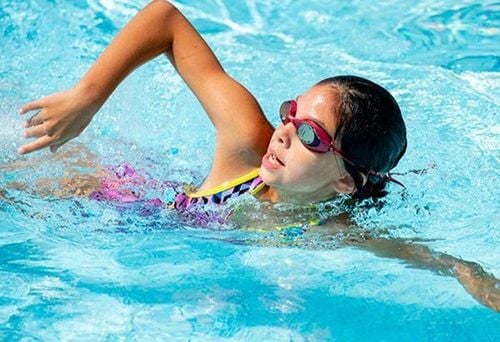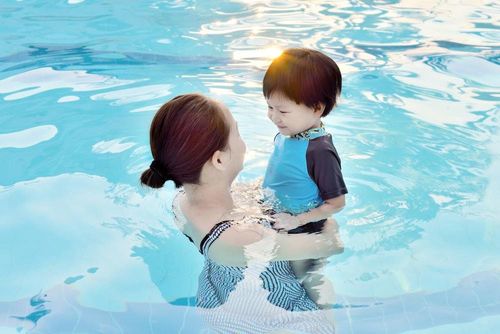This is an automatically translated article.
The article was professionally consulted by Specialist Doctor II Ho Viet Le Diem - General Internal Medicine - Department of Examination & Internal Medicine - Vinmec Central Park International General Hospital.Swimming is a great activity to cool off on summer days. However, besides that, you still run the risk of getting infections from coming into contact with the bacteria present in the tank. Here are a few swimming safety tips that will help you have a truly relaxing time at the pool.
1. What to pay attention to to ensure safety when swimming?
1.1 Shower before and after swimming A person in the pool can bring billions of bacteria down with them. The simple solution to avoid bringing bacteria into the pool is to stand under the faucet and rinse for 1 minute before getting in. At the same time, you should shower with soap after swimming to remove dirt left on the skin.1.2 Don't go swimming when you have diarrhea According to a 2017 survey, 25% of adults say they still go swimming when they have diarrhea. This is really a problem because the waste from swimmers with diarrhea can mix with the water in the swimming pool, more dangerous, it can create conditions for Cryptosporidium bacteria - a bacteria that spreads disease through contaminated feces. pollution - entering the water.
Once infected with this bacterium, the patient can continue to shed the parasite for the next 2 weeks after no longer having loose stools. Crypto parasites can live in tanks with a standard chlorine concentration for up to 10 days. Therefore, when you have diarrhea, you should not go to the swimming pool before 2 weeks from the time of illness.
1.3 Do not defecate in the water Children need to be reminded of this rule. Many people still think that chlorine has the effect of killing all the dirt in the swimming pool. In fact, body waste will reduce chlorine's ability to fight germs. In addition, it is quite impolite for swimmers to defecate or urinate in a swimming pool. If you witness such an action in a swimming pool, notify staff immediately to prevent this.
1.4 Using a Swim Diaper People who have to wear diapers frequently should put on a swim diaper or swimsuit before entering the water. The accompanying caregiver should check diapers hourly and change them in the restroom or changing room away from the pool area.
1.5 Leave the pool at least once an hour That's what the Centers for Disease Control and Prevention (CDC) recommends. This gives adults time to take children to the bathroom or change diapers.
Perform proper hand washing for children after using the toilet before entering the pool again.
1.6 Don't drink water in swimming pools

Không uống nước trong bể bơi
Do all you can to reduce the amount of water you drink from swimming pools. In addition, teach children that swimming pool water is not drinkable, they should keep their mouths closed and cover their noses when they put their heads in the water.
1.7 Test water quality with test strips If the pool has low chlorine or pH levels, bacteria will have more opportunity to grow and spread. If you are not sure if the pool water is clean, you should test it yourself with a test strip. Experts recommend that users use portable test strips to check the safety of water before taking a bath.
2. Diseases, infections and allergies after swimming
2.1 Diarrhea More than 80% of swimming pool illnesses are thought to be caused by Crypto bacteria. You can have loose stools 2 - 10 days after coming into contact with Crypto in a swimming pool.In addition, some other culprits cause other stomach infections such as Giardia, Shigella, norovirus and E. coli.
Symptoms: Diarrhea, abdominal cramps, nausea, vomiting, bloody stools, fever, dehydration. How to handle: Should take the patient to the doctor if there are signs of suspicion of illness. Most cases will clear up on their own, but excessive dehydration can lead to serious complications. If there is blood in the stool or a high fever, quickly see a doctor for examination and treatment. Prevention: Avoid drinking water in the pool. 2.2. Otitis externa otitis externa is an infection of the outer ear canal. The disease is not spread from person to person, but instead, it occurs because water stays in the ear canal for too long, allowing bacteria to grow and cause an ear infection. Swimming pool water is one of the biggest culprits of this disease.
Symptoms: Red, itchy, painful or swollen ears. What to do: See your doctor if you feel like you can't get all the water out of your ears or if you experience any of the above symptoms. Otitis externa is usually treated with antibiotic ear drops. Prevention: Try using earplugs while swimming. Consult your doctor for guidance on choosing the right earplugs and be provided with ear drops that reduce the risk of inflammation. After swimming, tilt your head to drain water from the ear canal and always dry your ears with a towel. 2.3 Skin rash This is called hot tub rash or folliculitis because it usually occurs after swimmers bathe in a contaminated hot tub, but it can also appear after swimming in pools. hot water is treated with poor hygiene. The bacteria Pseudomonas aeruginosa causes a rash that usually appears on the skin as a result of bacteria clinging to swimwear. So sitting for hours in a wet bathing suit may increase your risk of this condition.
Symptoms: Red, itchy bumps or small pus-filled blisters. What to do: See your doctor for a prescription for an anti-itch cream and an antibacterial cream. Prevention: Avoid shaving or waxing before bathing in the pool. Always shower again with soap and dry as soon as possible after bathing in a hot tub or swimming pool.

Viêm nang lông sau khi người bơi tắm trong bồn nước nóng bị ô nhiễm
Symptoms: Painful urination, frequent or bloody urination, pelvic or rectal pain, increased need to urinate. Treatment: Depending on the cause of the UTI, your doctor may prescribe antibiotics or antifungal medications. If you suspect a urinary tract infection, consult your doctor. Prevention: Shower and change wet clothes as soon as possible; Drink plenty of clean water after getting out of the pool. 2.5 Respiratory tract infections Legionnaires' disease is a type of pneumonia caused by Legionella bacteria. Swimmers can inhale bacteria from the steam from the hot tub. The illness develops 2 days to 2 weeks after exposure to the bacteria and is common in people over the age of 50, smokers, and people with weakened immune systems.
You may not realize that the air you are breathing from a swimming pool or hot tub is contaminated, so it is easy to be subjective with possible respiratory infections.
Normally, this bacteria is found in indoor swimming pools, but they can also live outside in warm, humid environments.
Symptoms: Chest pain, shortness of breath, fever, chills, coughing up blood. What to do: If any of the above symptoms occur, see a doctor immediately. Precaution: Use portable test strips to check the quality of the water in the pool before getting in the shower. Breathing problems after swimming can also be a sign of asthma or dry drowning, which is common in children.
2.6 Poisoning by denatured chlorine gas Contrary to what many people think, a strong chlorine smell does not mean that the pool is clean. The reality is exactly the opposite.
When germs, dirt and body cells combine with chlorine in the swimming pool, it will cause chlorine to have a pungent odor, flying into the air creating a chemical odor. Many people mistake this smell for the smell of a swimming pool with a standard chlorine concentration. In fact, a strong chlorine smell means that the chlorine in the tank has been depleted or degraded.
Therefore, you should not take a bath if you smell a strong chemical smell in the swimming pool. On the contrary, if the swimming pool has a pleasant smell, you can safely go to the bathroom.
Summer is the most suitable time for us to spend time swimming, both to help cool off and improve health and fitness. However, in order for swimming to not be counterproductive and harmful to health, you need to understand the above notes as well as prevent diseases that may be encountered during swimming.
Please dial HOTLINE for more information or register for an appointment HERE. Download MyVinmec app to make appointments faster and to manage your bookings easily.












